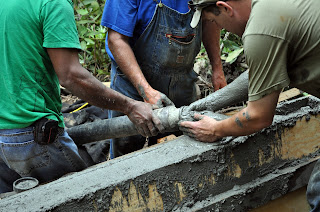In the first two posts we examined how the footers were dug, saw the first pouring of concrete for the footers, and the construction of wooden forms for casting the above ground concrete abutments were built.
Today, we will follow the process of filling the forms with concrete. One might ponder how do you get concrete from the BRP down to the river?
Here is what took place on a foggy, chilly, day in June....
Volunteers controlled the traffic flow along the parkway insuring no accidents while the trucks were along the roadside.
Here Margaret Lanman performs traffic safety, flag in one and walkie talkie in the other. Thanks for stepping up Margaret!Larry Hampton holds post on the opposite end of the section where we are working.
How nice to receive a nod of approval from our supportive and helpful BRP rangers.
This Loven concrete truck arrived shortly and positioned in place just above the concrete pumper.
The pumper is connected to a hose that is run from the roadside pumper to the creekside below. All concrete flows contained within this thick flexible 6 inch hose pipe. Note how it is supported above the river to be safe regarding contamination.
From the business end of the concrete truck
to the end of the hose below the concrete doth flow.
Here you can see the construction crew feeding the concrete behind the rebar in the open form.
As the call to stop pumping goes out to the crew up on the roadside, the last bit of concrete is massaged out with gravity assist.
The crew finishes off the top, leveling and grooming for the next stage.
Now positioned on the west side of the creek the crew begins to ready for filling the form.
From the top and below two men guide the concrete hose into the form.
Think about how heavy that hose filled with concrete must be.
This is what it looks like inside of the forms. Notice the drain pipe in place for flood stage drainage.
This rebar is drilled and set into the footer and then gridded for stability when cast in concrete.
The form is nearly filled.
The crew completes the pouring of the form before capping the top with the J bar (see part 2). We are so happy to have such a focused and attentive contractor. His men and his machines are getting the job done correctly with as little impact on the environment as possible. Thanks!




















No comments:
Post a Comment